Supply and exhaust ventilation: principle of operation and features of the arrangement
In a room filled with fresh air, it is easier to breathe, work more productively and sleep better. But opening a window for airing every 2-3 hours is problematic, do you agree? Especially at night, when all family members sleep sweetly.
One of the automated solutions for this task is the supply and exhaust ventilation (PVV) of the room. But how to make it right? We will help you learn the principle of work and deal with the features of the arrangement.
In our article, the constituent elements of the supply and exhaust system, the rules for their calculation and the norms of air exchange in rooms of various types are considered.
Schemes of arrangement of ventilation are selected, a photo depicting individual elements of the system, useful video recommendations on the installation of a ventilation system in a private house are given.
The content of the article:
What is ventilation?
How often do we air the room? The answer should be as honest as possible: 1-2 times a day, if you do not forget to open the window. How many times at night? Rhetorical question.
According to sanitary and hygienic standards, the total air mass in the room where people are constantly must be completely renewed every 2 hours.
Under the usual ventilation understand the process of exchange of air masses between a confined space and the environment. This molecular kinetic process provides the ability to remove excess heat and moisture using a filtration system.
Ventilation also ensures that indoor air meets sanitary and hygienic requirements, which imposes its own technological limitations on the equipment that will generate this process.
Ventilation subsystem - a set of technological devices and mechanisms for intake, removal, movement and purification of air. It is part of an integrated communications system for premises and buildings.
We recommend not matching concepts ventilation and air conditioning - very similar categories that have a number of differences.
- Main idea. Air conditioning provides support for certain parameters of air in a confined space, namely temperature, humidity, degree of ionization of particles and the like. Ventilation makes a controlled replacement of the entire volume of air through the inflow and exhaust.
- Main feature. The air conditioning system works with the air that is in the room and the influx of fresh air itself may be completely absent. The ventilation system always works on the border of a confined space and the environment through exchange.
- Means and methods. In contrast to simplified ventilation, air conditioning is a modular scheme of several units, which processes a small part of the air and thus maintains the sanitary and hygienic parameters of the air in the specified range.
System ventilation in the house can be expanded to any desired scale and provides, in case of emergency in the room, a fairly quick replacement of the entire volume of air mass. What happens with the help of powerful fans, heaters, filters and an extensive piping system.
You may be interested in the information on the arrangement of a ventilation duct made of plastic ducts, considered in our other article.

There are several classes of ventilation that can be divided with respect to the method of generating pressure, distribution, architecture and purpose.
Artificial air injection in the system is carried out using blower units - fans, blowers.By increasing the pressure in the piping system, you can move the air-gas mixture over long distances and in a significant volume.
This is typical for industrial facilities, production facilities and public facilities with a central ventilation system.
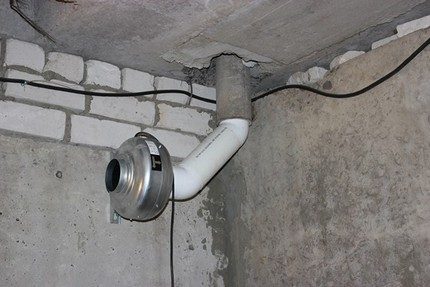
Consider ventilation systems local (local) and central. Local ventilation systems - “point” narrowly targeted solutions for specific rooms where strict compliance with standards is required.
Central ventilation provides the ability to create a regular air exchange for a significant number of identical premises.
And the last class of systems: supply, exhaust and combined. Supply and exhaust ventilation systems provide simultaneous inflow and exhaust of air in space. This is the most common subgroup of ventilation systems.
Such designs provide easy scaling and maintenance for a wide variety of industrial, office and residential buildings.
The physical basis of the ventilation system
The supply and exhaust ventilation system is a multifunctional complex of ultrafast processing of a gas-air mixture. Although this is a system of forced gas transportation, it is based on completely explainable physical processes.
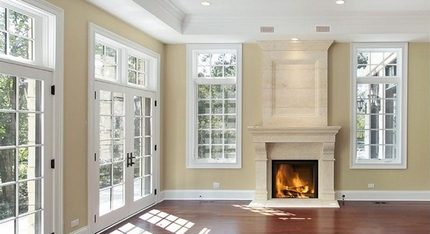
The word “ventilation” itself is closely related to the concept of convection. It is one of the key elements in moving air masses.
Convection is the phenomenon of circulation of thermal energy between cold and warm gas flows. There is natural and forced convection.
A bit of school physics to understand the essence of what is happening. The temperature in the room is determined by the temperature of the air. Carriers of thermal energy are molecules.
Air is a multi-molecular gas mixture that consists of nitrogen (78%), oxygen (21%) and other impurities (1%).
Being in a confined space (room), we have a heterogeneity of temperature with respect to height. This is due to the heterogeneity of the concentration of molecules.
Given the uniformity of gas pressure in a confined space (room), according to the basic equation of the molecular-kinetic theory: pressure is proportional to the product of the concentration of molecules and their average temperature.
If the pressure is the same everywhere, then the product of the concentration of molecules and temperature in the upper part of the room will be equivalent to the same product of concentration and temperature:
p = nkT, ntop* Ttop= nbottom* Tbottom, ntop/ nbottom= Tbottom/ Ttop
The lower the temperature, the greater the concentration of molecules, and therefore the greater the total mass of the gas. Therefore, it is said that warm air is “lighter” and cold air is “heavier”.
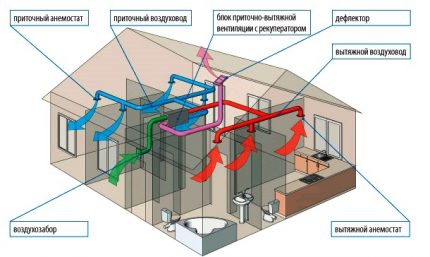
In connection with the foregoing, the basic principle of the arrangement of ventilation becomes clear: air supply (inflow) is usually equipped at the bottom of the room, and exhaust (exhaust) - at the top. This is an axiom that must be considered when designing a ventilation system.
Features of supply and exhaust ventilation
Supply and exhaust ventilation interacts with two air streams of different composition and purpose, which are subsequently processed.
In PVV, all the necessary equipment and additional systems are placed in a single frame, which can be installed inside the loggia, in the attic, on the wall outside the house, etc.
The special design of the installation provides ample opportunity to provide ventilation of almost any number of rooms in the building.
In addition to the main function of moving air, the supply and exhaust ventilation includes the following arsenal of auxiliary subsystems and additional functions.
Among which are the following:
- air cooling and heating;
- ionization and hydration of particles;
- disinfection and air filtration.
Consider a typical duty cycle of a supply and exhaust ventilation system, which is based on a two-circuit transportation model.
At the first stage, the intake of cold air from the environment and the extraction of warm air from the room. On both sides, the air goes through a cleaning system.
After that, cold air is transferred to air heater (heater) - it is characteristic for PVV with heat recovery. In addition, heat is transferred to cold gas from warm exhaust air - typical of conventional systems.
After heating and heat exchange, exhaust exhaust air is discharged through an external channel, and heated fresh air is supplied to the room.
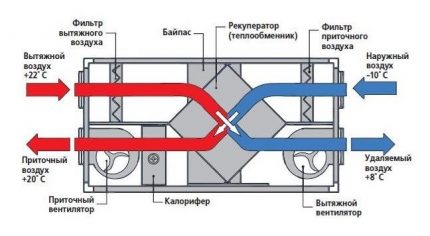
The main principles of supply and exhaust ventilation are efficiency and economy.
The classical scheme of supply and exhaust ventilation has the following advantages:
- high degree of purification of the input stream
- affordable operation and maintenance of removable elements
- design integrity and modularity.
To expand the functionality, the supply and exhaust systems are equipped with auxiliary control and monitoring units, filter systems, sensors, self-timers, silencers, signaling devices for overloading electric motors, recuperative blocks, condensate trays, etc.
Dynamic ventilation parameters
A lot of questions are associated with the design of a ventilation system, because in the case of an erroneous calculation of characteristics from a completely economical ventilation complex, you can get a wasteful “monster” of energy resources.
Which directly affects the financial costs of its maintenance. As a result, the idea of economical operation of the equipment is not considered.
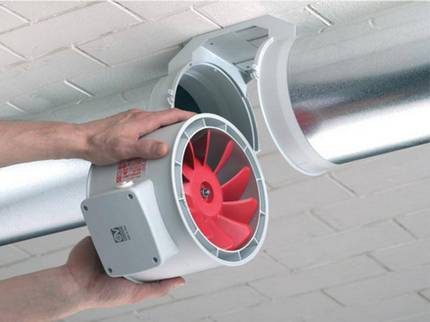
In order to correctly design the supply and exhaust ventilation, it is recommended to perform algebraic calculations of the unit's performance and dynamic parameters of air flows.
There are several different calculation methods and algorithms, but one of the simplest and most reliable options will be presented to our attention.
All that is associated with secondary processes of hydration, additional ionization and secondary purification at this stage can be ignored.
Settlement Standards
Provide a complete list of sanitary norms and rules (SNiP) that are put forward to various ventilation systems is irrational, since there is enough material for a couple of books, but you need to know the reference constants for residential and office premises.
As for office premises, when building a ventilation system, the main attention is paid to those rooms where the office personnel will be located.
Further, all standards are indicated per person. In a classic office building on one floor there is a complete set of premises for various purposes.
For example, in an office in one hour, 60 cubic meters of air should be replaced, in operating rooms - 30-40 m3, in the bathroom - 70 m3, in the smoking room - more than 100 m3, in the corridors and lobby - 10 m3.
According to the general sanitary standards for residential premises, in one hour there is a complete exchange of air mass in the amount of 30 m3 per person - based on the number of residents.
There is another approach in calculating the volume of air - by area. 3 m per square meter of living space3.

For the remaining utility rooms, there are ready-made regulatory parameters. So, a kitchen with an electric stove - more than 60 m3, with a gas stove - more than 80 m3, bathroom - at least 25 m3 etc.
In addition, it must be remembered that for living rooms the air flow rate is not more than 2 m / s, and for the kitchen and bathroom the speed should be 4-6 m / s.
Formulas and explanations to them
We pass directly to the characteristics and formulas. The calculations take place in several stages, at each of which we calculate one of the characteristics of the ventilation system.
Air displacement
Consider the calculation of the working volume of air (m3/ h).
For the office, we recommend calculating the number of people:
V = 35 * N,
Where N - the number of people simultaneously in the room.
For apartments and private houses, it is necessary to make a miscalculation regarding the volume of living space:
V = 2 * S * H,
Where: 2 - the coefficient of multiplicity of air exchange per unit time (for 1 hour); S - living space; H - the height of the premises.
The calculation of the cross section of the duct
Section ventilation duct calculated in cm2. Main air ducts are of two types in cross section: round and rectangular.
The cross-sectional area of the pipe is calculated by the ratio:
Scut= V * 2.8 / ω,
Where: Scut - cross-sectional area; V - air volume (m3/ h); 2,8 - coefficient of coordination of dimensions; ω - flow rate in the highway (m / s).
The flow rate of air passing through the highway is usually equivalent to 2-3 m / s.
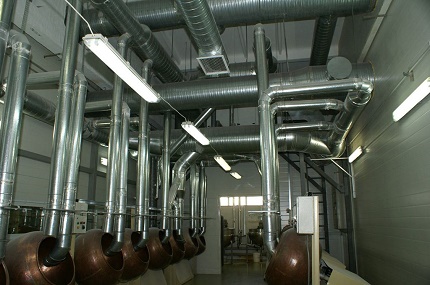
Number and size of diffusers
Let us further consider how to calculate the number and size of diffusers. Sprayer dimensions are usually chosen 1.5-2 times more than the cross-sectional area of the main line.
With the number of diffusers a little more complicated, they are calculated by the formula:
N = V / (2820 * ω * d2),
Where: N - the desired number of diffusers; V - air mass flow (m3/ h); ω - air flow rate (m / s); d - diameter of the diffuser (m), if it is round.
If the diffuser is rectangular, then:
N = π * V / (2820 * ω * 4 * a * b),
Where: π - Pi, a and b - dimensions of the section.
Installation Performance Options
Two of the most important characteristics of a ventilation unit are known - power and the degree of pressure generated. The power of the ventilation station is calculated as follows:
P = ΔT * V * Cv / 1000,
Where: ΔT - delta of inlet / outlet air temperatures (° С); V - air mass flow (m3/ h); Cv - heat capacity of air (0.336 W * h / m³ * ° С).
The generated pressure is determined by the characteristic curve of the performance of the main fan.
This parameter should be equivalent to the aerodynamic drag of the air network. Fan manufacturers provide a graph of the curve in the product data sheet.
In addition, it is important to have a general idea about the heater of the inlet air flow - the heater. This is a separate part of the ventilation system where air is heated. Passing, for example, through a heat sink, the air is thereby heated.
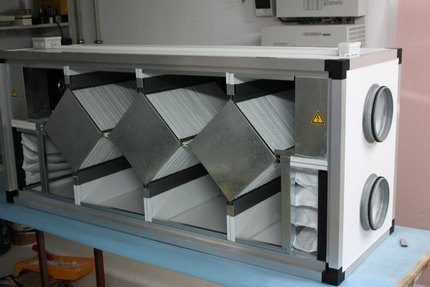
In conclusion, it is worth mentioning the supply voltage for the ventilation unit. It is recommended to use a voltage network of 380 V, it will ensure reliable operation of the installation of any power.
Specifics of mechanical ventilation installation
With the installation of a ventilation unit of a supply type, the home master could no doubt manage without attracting workers.
However, it is worth remembering that work is carried out at a dangerous height for an inexperienced performer. Therefore, it is better to attract those who have experience, tools and safety devices to perform the following steps:
Upon completion of the completely difficult manipulations on the installation of the direct air supply unit, it remains only to connect it to the communications.
Let us consider this process in more detail using the following photo selection.
Information about the installation sequence of forced ventilation units will help to avoid many of the gross errors made by inexperienced installers.
Features of the construction of natural PVV
When developing high-quality natural supply and exhaust ventilation, most specialists observe a certain “charter” of design and installation works.
These rules help create truly effective and cost-effective solutions for even the most non-standard layouts of rooms and utility rooms. in a private house and multi-room apartment high-rise buildings.
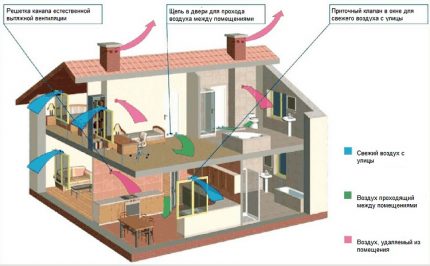
Corridors in this case act as flowing spaces. Therefore, the main ventilation unit of the system must be located in the center of the house, in the upper part of the corridors or utility rooms.
For example, the ventilation module for a 2-story private house can be located on the ground floor at the top of the utility room or the main corridor. For a 1-storey building, as an option, in the lower part of the attic.
When laying the main pipeline, you need to remember that the supply air must go into the living rooms, and the exhaust air must go through the kitchens and utility rooms.
Therefore, the supply air diffusers are located on the conditional boundary “room-environment”, and the hoods in the kitchen, in the bathroom, utility room, toilet.
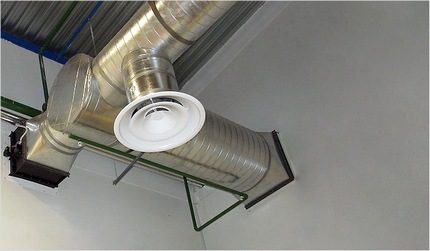
There are comments regarding the height of the location of the inlet and outlet air openings. The outlet of the ventilation system is placed necessarily above the roof level of the building.
This will protect the air intake from the secondary intake of freshly removed air through the exhaust openings.
Fresh air must be taken at a height of at least 2 meters from the surface of the earth.
Because small abrasive particles and dust can rise with the help of wind flows to a height of more than 1 meter and fly into the supply air diffusers, thereby quickly clogging the primary filters.
Conclusions and useful video on the topic
The video tells and demonstrates the features of the design and installation of PVC in a private house:
Another illustrative example of a turnkey solution for ventilation of a private 1-story wooden house:
Summarizing the above information, we note that the supply and exhaust ventilation is simple for design, available for purchase and installation of the system.
Ventilation in conjunction with the heating system allows you to organize a balance of fresh and warm air in the room.
Did you arrange ventilation in the country? Or do you know the secrets of designing and installing a ventilation system in an apartment? Please share your experience - leave your comments on this article.

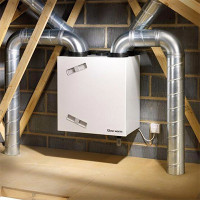 Supply and exhaust ventilation with heat recovery: operating principle, an overview of the advantages and disadvantages
Supply and exhaust ventilation with heat recovery: operating principle, an overview of the advantages and disadvantages 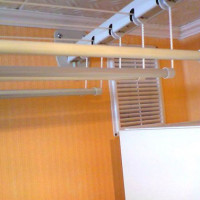 Ventilation in the wardrobe: features of the arrangement of the hood in the dressing room and wardrobe
Ventilation in the wardrobe: features of the arrangement of the hood in the dressing room and wardrobe 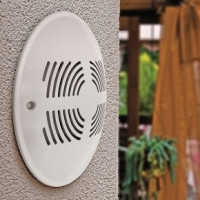 Supply ventilation valve into the wall: features of the arrangement
Supply ventilation valve into the wall: features of the arrangement 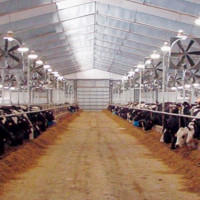 Do-it-yourself ventilation of the barn: types of systems, air exchange rates + system arrangement
Do-it-yourself ventilation of the barn: types of systems, air exchange rates + system arrangement 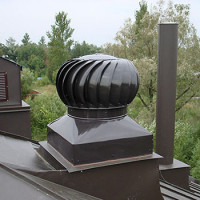 Turbo deflector for ventilation: principle of operation and comparison of types of rotational deflectors
Turbo deflector for ventilation: principle of operation and comparison of types of rotational deflectors 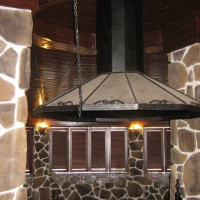 Exhaust hood for the kitchen: operating principle, device, types of units
Exhaust hood for the kitchen: operating principle, device, types of units  How much does it cost to connect gas to a private house: the price of organizing gas supply
How much does it cost to connect gas to a private house: the price of organizing gas supply  The best washing machines with dryer: model rating and customer tips
The best washing machines with dryer: model rating and customer tips  What is the color temperature of light and the nuances of choosing the temperature of the lamps to suit your needs
What is the color temperature of light and the nuances of choosing the temperature of the lamps to suit your needs  Replacement of a geyser in an apartment: replacement paperwork + basic norms and requirements
Replacement of a geyser in an apartment: replacement paperwork + basic norms and requirements
I really liked the way of using ventilation as a component of the interior. It’s good that you explained the principle of the ventilation system, now at least I know how it all works. I did not suspect that ventilation could cool or heat the air, this is very useful information. I especially liked these informative videos at the very bottom of the page.
The article describes the installation phase of the V-STAT FKO 4A installation, but now the new Satellite model is released, much better and more compact. It looks like an external air conditioning unit.
Hello. As I understand it, your article contains a contradiction that I would like to resolve. First, it is indicated that “To create the effect of natural convection of air currents, heat sources are placed as low as possible, and the supply elements in the CEILING or under it” (under the photo of the living room with a fireplace).
After a few paragraphs, the situation changes to the opposite: “In connection with the foregoing, the basic principle of arranging ventilation becomes clear: the air supply (inflow) is usually equipped LOWER, and the outlet (exhaust) is on top. This is an axiom that needs to be considered when designing a ventilation system. ”
So where is the correct inflow to be made: above or below?
Hello. I’m not a super-professional in ventilation, but I’ll try to explain.
Infusion can be carried out in 4 main ways - top-down, top-up, bottom-up, bottom-down.
The first 2 methods are used when the air taken from the street in the winter and off-season is much lower than the room temperature, and the air pressure and humidity outside the window are higher.
The second and third are the most common in the natural type of ventilation device.
In the picture with a fireplace, the intake is most suitable for a room with such a device, which requires a competent arrangement of the supply system.